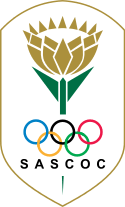South African Sports Confederation and Olympic Committee
|
South African Sports Confederation and Olympic Committee logo | |
| Country/Region |
|
|---|---|
| Code | RSA |
| Created | 1991 |
| Recognized | 1991 |
| Continental Association | ANOCA |
| Website | sascoc.co.za |
South African Sports Confederation and Olympic Committee (SASCOC) (Afrikaans: Suid-Afrikaanse Sportkonfederasie en Olimpiese Komitee) is a non-profit company that serves as the National Olympic Committee (NOC) and National Paralympic Committee (NPC) for South Africa and the controlling body of all performance sports of South Africa and coordinates the relationship with various international sports federations.[1] It is also the body responsible for South Africa's representation at the Commonwealth Games.[2]
At the Annual General Meeting held on 9 December 2013, SASCOC decided to de-register as a Non Profit company. This has created a great deal of confusion as its status as the official Sports Confederation (in terms of the Sport and Recreation Act, number 110 of 1998, as amended) and its affiliation to the IOC, ANOCA and the Commonwealth are not transferable.
Currently there is an Association that is attempting to trade as SASCOC. However this association is not a registered non-profit organisation and in terms of its constitution (as can be seen on its website) it cannot be adopted as such either. Thus the association is a taxable partnership in which all the 'Board Members' are partners and share in the profit and losses of such body.
Currently both SASCOC's are under investigation by the Public Protector and even the National Lottery Board has initiated a forensic audit into the amounts paid across by itself to SASCOC.
History
The South African Sports Confederation and Olympic Committee (SASCOC) is the controlling body for all high performance sport in South Africa and was formed as a Section 21 Company by representatives of all the sports bodies at a general meeting held on 27 November 2004.
In terms of the Memorandum of Association, the main object is to promote and develop high performance sport in the Republic of South Africa as well as and to act as the controlling body for the preparation and delivery of Team South Africa at all multi-sport international games including but not limited to the Olympics, Paralympics, Commonwealth Games, World Games and All Africa Games.
It is also required:
- to assume those functions relating to high performance sport which were carried out by the following controlling bodies in the Republic of South Africa:
- Disability Sport South Africa (Association incorporated under Section 21);
- National Olympic Committee of South Africa;
- South African Commonwealth Games Association (Association incorporated under Section 21);
- South African Sports Commission;
- South African Student Sports Union;Sport and Recreation South Africa; and
- United School Sports Association of South Africa;
- to affiliate to and/or be recognized by the appropriate international, continental and regional sport organisations for high performance sport and for that purpose act as the recognized national entity for the Republic of South Africa;
- to initiate, negotiate, arrange, finance and control where necessary, multi-sport tours to and from the Republic of South Africa inclusive of events between teams and/or individuals;
- to ensure, and if necessary approve, that the bidding process relating to the hosting of international sporting events in the Republic of South Africa or any other events are in compliance with the necessary rules and regulations relating to same;
- to facilitate the acquisition and development of playing facilities including the construction of stadia and other sports facilities;
- to ensure close co-operation with both the government and private sector, relating to all aspects of Team South Africa;
- to ensure the overall protection of symbols, trademarks, emblems or insignia of the bodies referred to in 1g within the Association’s jurisdiction.
The Executive of SASCOC comprises a President, a 1st and a 2nd Vice President, five elected members, any IOC member resident in South Africa, one member appointed by each of DISSA, SASSU and USSASA and one member representing the Athletes Commission.
SASCOC was formed following a long process which commenced with the formation of a Ministerial Task Team established by former Minister of Sport, the Hon Ncgonde Balfour and chaired by the CEO of the Sports Commission, Joe Phaahla. The recommendations of this task team were then handed over to a Steering Committee to implement the recommendations led by Willie Basson and with representation from all the macro sporting bodies in South Africa. The work of this Steering Committee was delegated to various sub-committees and the process culminated in the formation of SASCOC.
The various predecessor bodies of SASCOC were dissolved during the course of 2005 and their functions, insofar as they relate to high performance sport, were taken over by SASCOC. All other functions which relate to Mass Participation in sport will become the responsibility of Sport and Recreation South Africa.
The Founding Members of SASCOC have unequivocally pledged to unite and commit themselves towards an improved system based upon the principles of equal opportunity, non racialism and non sexism for all persons, and have dedicated themselves to ensuring equitable development at national and representative level, which ensures the implementing of co-ordinated sports procedures and policies, which would ensure elite levels of athleticism, thus allowing delivery of Team South Africa by the pooling of activities, resources, experience and expertise, as well as co-ordinating the preparation, presentation and delivery of Team South Africa to any elite high performance event worldwide.
References
- ↑ "History". South African Sports Confederation and Olympic Committee. Retrieved 29 March 2011.
- ↑ "South Africa at the Commonwealth Games". Commonwealth Games Federation. Retrieved 22 November 2012.
External links
| |||||||||||||||||||||||||||||
| ||||||

